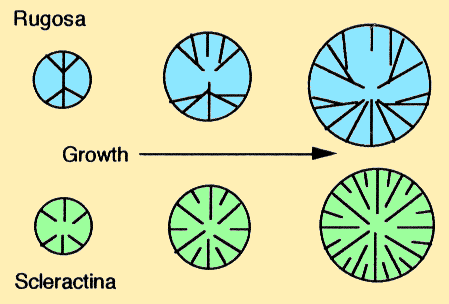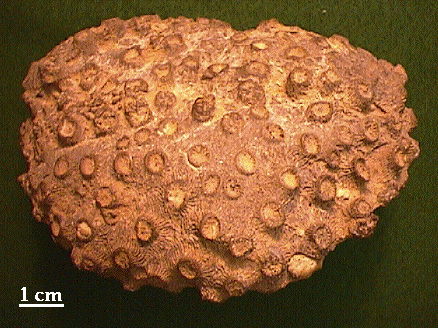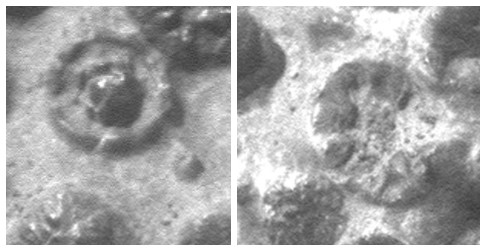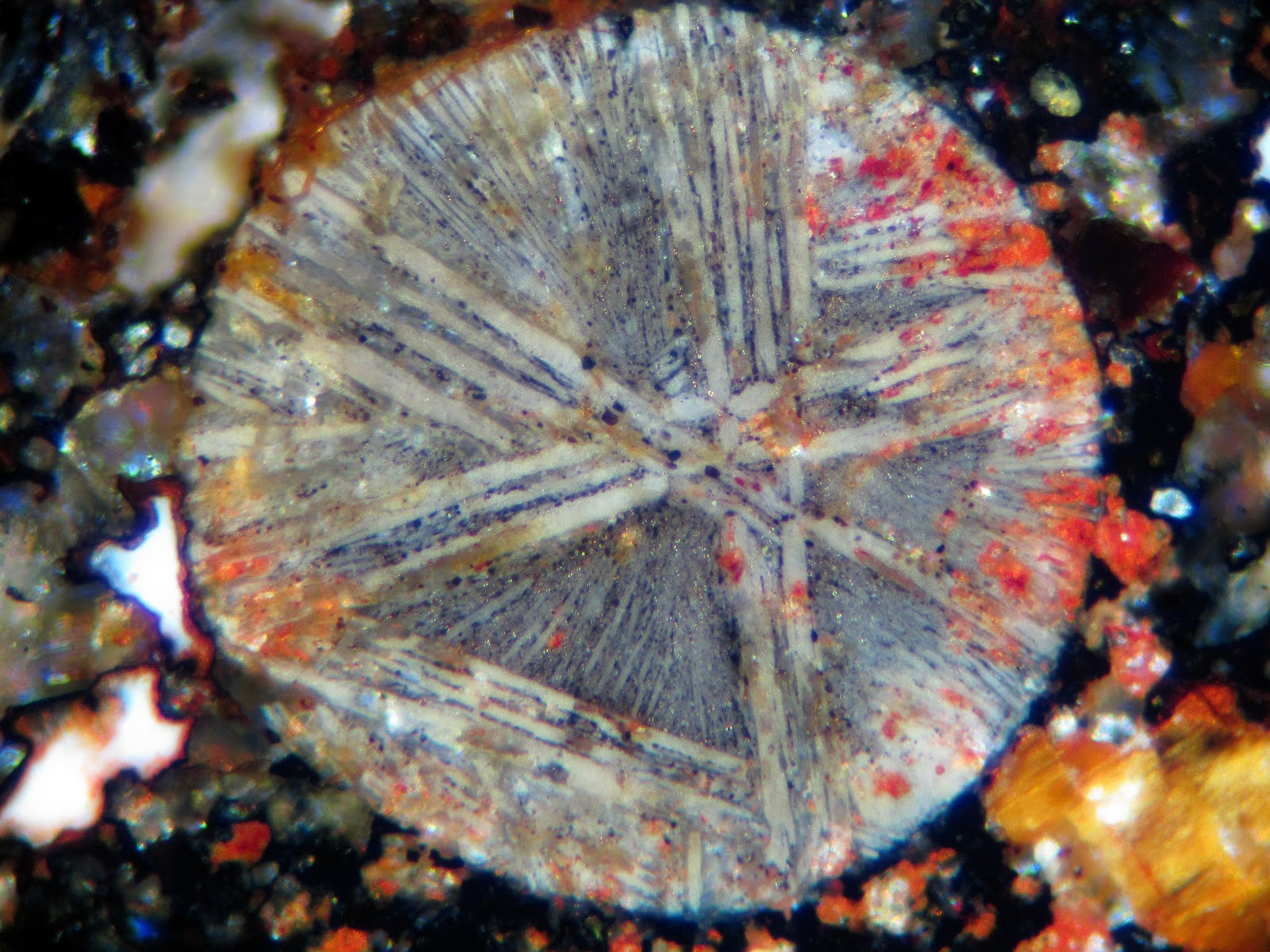It looks like you're using an Ad Blocker.
Please white-list or disable AboveTopSecret.com in your ad-blocking tool.
Thank you.
Some features of ATS will be disabled while you continue to use an ad-blocker.
share:
Very cool, this is the first time I've seen this rock.. it most definately looks carved or chiseled. I see right triangle, rectangle and other
geometric shapes that look to precise to be "erroded". If one or another was found on different stones. Then I might consider it being a pretty cool
fluke. With all those on the same side of the same stone though... Unless this turns out to be a hoax.. then this is by far the best evidence that
there's more going on with mars than just "rocks"..
originally posted by: Char-Lee
a reply to: charlyv
This is a specific aggregate mixed in with a sand, clay or calcium-carbonate matrix.
Interesting could you link me where this is from?
It doesn't matter, as you likely already know conglomerates can be natural or artificially formed.

edit on 22-9-2014 by smurfy because: Image.
originally posted by: smurfy
originally posted by: Char-Lee
a reply to: charlyv
This is a specific aggregate mixed in with a sand, clay or calcium-carbonate matrix.
Interesting could you link me where this is from?
It doesn't matter, as you likely already know conglomerates can be natural or artificially formed.
Artificial conglomerates are really off the map here. There are so many examples of naturally occurring conglomerate material on this Earth that it would fill books. However, most conglomerates that we know of contain many different specific inclusions, which does not really fit this presentation. What does satisfy it are materials that are known to induce crystal growth, and they are not classified as conglomerates. This is IMHO only, as some geologists would give their eye teeth to get a sample of something like this, and some day, we will most certainly be able to attain that. Still, my curiosity is so provoked, and wonder why the decision making apparatus at NASA is not looking at this in a much more curious fashion.
originally posted by: Char-Lee
a reply to: charlyv
This is a specific aggregate mixed in with a sand, clay or calcium-carbonate matrix.
Interesting could you link me where this is from?
I have no specific link, it is just classic geology. It is obvious to me that it is a substrate matrix that induces crystal growth which has many simile on Earth. Conglomerates have inclusions of many different types of other materials. That does not seem to be the case here. It is IMHO, but based on my experience only. The specifics of this are everywhere on geology sites on the web. One would be: Rock Matrix that induce crystal growth
originally posted by: charlyv
It is obvious to me that it is a substrate matrix that induces crystal growth which has many simile on Earth. Conglomerates have inclusions of many different types of other materials. That does not seem to be the case here. It is IMHO, but based on my experience only.
The specifics of this are everywhere on geology sites on the web. One would be:
Rock Matrix that induce crystal growth
As long as we don't know what exactly we're looking at, your interpretation is just as legit as any other. So thanks for sharing your personal experience in this thread.
I've also considered a crystalline explanation for Kirkwood at first, but I couldn't find any morphology that comes close enough to match the features we see. Personally, I think that organic growth of these patterns is more likely. I'm strongly reminded of something like rucosa coral (or lichen) colonies - possibly with a variety of other organisms preserved inbetween. Here a typical growth pattern of rugosa corals (and a chunk of fossilized rugosa, bottom):


The degree of erosion obviously differs from what we see at Kirkwood, since we can't really make out the fine lamination at the base, but the general morphology seems to be a good match. And here goes another example from Kirkwood: a concentric shape with a circular structure in the center (left) and another one with radial segmentation around the center (right), which IMO are also very reminiscent of organic growth:

Whether geo- or biochemistry was at work here, I think we're looking at an intriguing part of the martian landscape and I also wonder whether or not Opportunity might find its way back to the Kirkwood outcrop for further investigations ...
edit on 23-9-2014 by jeep3r because: text
originally posted by: jeep3r
originally posted by: charlyv
It is obvious to me that it is a substrate matrix that induces crystal growth which has many simile on Earth. Conglomerates have inclusions of many different types of other materials. That does not seem to be the case here. It is IMHO, but based on my experience only.
The specifics of this are everywhere on geology sites on the web. One would be:
Rock Matrix that induce crystal growth
As long as we don't know what exactly we're looking at, your interpretation is just as legit as any other. So thanks for sharing your personal experience in this thread.
I've also considered a crystalline explanation for Kirkwood at first, but I couldn't find any morphology that comes close enough to match the features we see. Personally, I think that organic growth of these patterns is more likely. I'm strongly reminded of something like rucosa coral (or lichen) colonies - possibly with a variety of other organisms preserved inbetween. Here a typical growth pattern of rugosa corals (and a chunk of fossilized rugosa, bottom):
Source
The degree of erosion obviously differs from what we see at Kirkwood, since we can't really make out the fine lamination at the base, but the general morphology seems to be a good match. And here goes another example from Kirkwood: a sphere with a circular structure in the center (left) and another sphere with radial segmentation around the center (right), which IMO are also very reminiscent of organic growth:
Source
Whether geo- or biochemistry was at work here, I think we're looking at an intriguing part of the martian landscape and I also wonder whether or not Opportunity might find its way back to the Krikwood outcrop for further investigations ...
Ok, you have my undivided attention.
I am very intrigued at your morphology observation, however you do realize that crystalline structures also have these properties, especially if interrupted by immersion in water or driven below the surface and exposed to other minerals.
I specialize in Geology, but in primitive life forms, there are places where science "at a distance", becomes a firewall that requires detailed forensic analytics to go forward.
A coral type of living entity would be the only simile I could entertain as a possibility here, but there would be clues in the mineral structures that could prove that. This is why I would assume NASA should be all over this, as the people behind most of these experiments are some of the best geologists and life science people available. So... I also hold that these photographic "abnormalities" have not escaped their observation either, and they have either already examined them or have overlooked them, which is disturbing both ways because we have no data from them to support anything we are discussing here, in the detail that are obviously required to go further.
Just for the sake of physical appearance, I present a micro-graph of a chondrule in a meteorite, as an example of crystalline structure, in the most
primitive of mineral compositions we know of in the solar system.

This image of primordial material needs to be compared to any physical entity we come across, when we are talking about the physical appearance of minerals that do not originate on this Earth, but are certainly found in their pristine forms on the surface of the Earth.

This image of primordial material needs to be compared to any physical entity we come across, when we are talking about the physical appearance of minerals that do not originate on this Earth, but are certainly found in their pristine forms on the surface of the Earth.
edit on 23-9-2014
by charlyv because: content
a reply to: jeep3r
I was always sceptical of any complex life or fossils of complex life being found on Mars. The only life analog we have is Earth, and complicated organisms didnt start appearing on this planet until around 500 million years ago. Before that it was all single celled organisms. If you extrapolate the same time line with Mars, Mars loses its oceans about 3 billion years ago, long before complex organisms would have had time to develop. That being said, its entirely possible that Mars underwent an entirely different evolution than Earth. It is after all a much smaller planet, maybe things could have taken place at an accelerated pace because the oceans were smaller and organisms were more crowded together and had to adapt more quickly to survive a harsher environment. Its also possible that complex life developed on Earth multiple times,ie much earlier than we think, only to be wiped out by asteroid impacts and volcanism etc. Having grown up in an area with a lot of fossil laden limestone deposits, I can say that the image DOES look like fossils to me. the distribution of the objects in the rock and their orientation looks exactly like the way fossils are distributed in limestone sometimes. S&F.
I was always sceptical of any complex life or fossils of complex life being found on Mars. The only life analog we have is Earth, and complicated organisms didnt start appearing on this planet until around 500 million years ago. Before that it was all single celled organisms. If you extrapolate the same time line with Mars, Mars loses its oceans about 3 billion years ago, long before complex organisms would have had time to develop. That being said, its entirely possible that Mars underwent an entirely different evolution than Earth. It is after all a much smaller planet, maybe things could have taken place at an accelerated pace because the oceans were smaller and organisms were more crowded together and had to adapt more quickly to survive a harsher environment. Its also possible that complex life developed on Earth multiple times,ie much earlier than we think, only to be wiped out by asteroid impacts and volcanism etc. Having grown up in an area with a lot of fossil laden limestone deposits, I can say that the image DOES look like fossils to me. the distribution of the objects in the rock and their orientation looks exactly like the way fossils are distributed in limestone sometimes. S&F.
a reply to: openminded2011
It is possible that life forms were introduced to both planets through the process of "Panspermia". They would never have evolved beyond the simple forms on mars but would have had time to do so on earth.
PANSPERMIA - The process by which simple life forms are introduced to a world from some undetermined source in outer space. On most of the planets in the solar system any life form would be quickly destroyed, but on a select few, like Earth and Mars, they could have flourished. But since Mars didn't have conditions favorable to them for long enough they would have developed only to a certain point and never made it to the complexity we know as life today.
It is possible that life forms were introduced to both planets through the process of "Panspermia". They would never have evolved beyond the simple forms on mars but would have had time to do so on earth.
PANSPERMIA - The process by which simple life forms are introduced to a world from some undetermined source in outer space. On most of the planets in the solar system any life form would be quickly destroyed, but on a select few, like Earth and Mars, they could have flourished. But since Mars didn't have conditions favorable to them for long enough they would have developed only to a certain point and never made it to the complexity we know as life today.
originally posted by: jeep3r
As I'm personally most interested in this particular subject, I'd appreciate any comments, opinions or even comparisons with similar features on Earth (if there are any) ... so I'm very much looking forward to your thoughts on this!

The area circled in red OP does appear to be related to some biological kind of formation somehow "frozen" or trapped from sediment movement or heat/chemical exposure.
The many semi spheres can also be the effects of some kind of chemical change associated with the imaged material being heated or froze which has began to expand or secrete another material from within... Either way interesting share
As I've followed this thread I've held off from commenting, as I'm not a geologist or a biology or marine-biology expert (although yes, I have
played all of them on both radio and television), and awaited comments by professionals in their fields. I didn't see this a few months ago, so this
thread is the first time. So, to comment, verrrryyyyyyy nice find. This is one of those 1 percent possibilities I mention sometimes - that the odds of
it being a fossilized lifeform(s) is at least 1 percent and thus worthy of study and analysis by those experts.
And as I also point out from time to time, on the grand scale of things and flow of time, humans are at the very beginning of their pioneering exploration of Mars. So finds like this - be they rocks, fossils, or wind-eroded whatsyamacallits - join the data collected in that era. Great find and thread.
And as I also point out from time to time, on the grand scale of things and flow of time, humans are at the very beginning of their pioneering exploration of Mars. So finds like this - be they rocks, fossils, or wind-eroded whatsyamacallits - join the data collected in that era. Great find and thread.
originally posted by: charlyv
Still, my curiosity is so provoked, and wonder why the decision making apparatus at NASA is not looking at this in a much more curious fashion.
That's the thing, they ground out and destroyed the 'artifact' that Hoover maintains was a clinoid fossil, no one was giving their eyeteeth away there! Yet and all, a few years later NASA wants to go back and study, (reavaluate?) that spot at Kirkwood, despite all.
As jeep3r mentions Corals, what better a place, Corals are riven with Clinoid sponges that burrow into them amongst other creatures, so just supposing that the Kirkwood rock was a coral 'city' complete with inhabitants?
If Hoover thought that it was definitely a Crinoid fossil, them he must be further thinking along the lines of other types of fossils, likely embedded in Coral as well.
originally posted by: Aleister
This is one of those 1 percent possibilities I mention sometimes - that the odds of it being a fossilized lifeform(s) is at least 1 percent and thus worthy of study and analysis by those experts.
Thanks, Aleister ... I'm glad the feature made it into the 1% category you introduced (which, by the way, is an interesting filtering method IMO).
I hope that even more people are going share their opinion with us ... no matter whether it's laypersons, experts, part-time fossil-hunters or regular members on here, I'm interested in everybody's point of view!
originally posted by: charlyv
Just for the sake of physical appearance, I present a micro-graph of a chondrule in a meteorite, as an example of crystalline structure, in the most primitive of mineral compositions we know of in the solar system.
Good research and an interesting alternative explanation, charlyv ... and here goes a stereoscopic view of a fossilized rugose coral specimen:

The above example would IMO better explain the central features within the semi-spheres of the Kirkwood panorama. Also, as someone mentioned before: the overall distribution of the features on the outcrop also seems to match the way such colonies spawn here on earth.
I will see if I can identify even more unique features on the various Kirkwood images in order to draw comparisons between these and similar terrestial formations ...
originally posted by: jeep3r
I will see if I can identify even more unique features on the various Kirkwood images in order to draw comparisons between these and similar terrestial formations ...
Well, I sure do see the similarities between Richard Hoover's Crinoid top with it's bifurcations, (the divisions I arrowed), and your object of interest, (I also arrowed them) no matter how tenuous it might seem to us, it was goldust to Hoover.
Have a look anyway.


originally posted by: smurfy
Well, I sure do see the similarities between Richard Hoover's Crinoid top with it's bifurcations, (the divisions I arrowed), and your object of interest, (I also arrowed them) no matter how tenuous it might seem to us, it was goldust to Hoover.
Yes, that's one of the most obvious parallels. The segmentation is clearly visible and highly reminiscent of terrestial crustaceans, eg. a jurassic shrimp:

I was also thinking about the other distictive shapes visible in the panorama and the many Kirkwood images (of which the pano is just a part). I'll have a look into that and post anything of interest later on ...
a reply to: smurfy
I think you mean Richard Hoagland, not Hoover. Hoagland found that first object and I don't think he's found anything really interesting in the Mars fossil department ever since (although his website, Enterprisemission, is very entertaining). Maybe he already reads these threads, and hopefully can help distribute this current lots-of-things-in-a-rock and some of the other finds on ATS on his site (with proper credit, if he'd be so kind and noble, a gentleman while sometimes a scholar).
I think you mean Richard Hoagland, not Hoover. Hoagland found that first object and I don't think he's found anything really interesting in the Mars fossil department ever since (although his website, Enterprisemission, is very entertaining). Maybe he already reads these threads, and hopefully can help distribute this current lots-of-things-in-a-rock and some of the other finds on ATS on his site (with proper credit, if he'd be so kind and noble, a gentleman while sometimes a scholar).
originally posted by: Aleister
a reply to: smurfy
I think you mean Richard Hoagland, not Hoover. Hoagland found that first object and I don't think he's found anything really interesting in the Mars fossil department ever since (although his website, Enterprisemission, is very entertaining). Maybe he already reads these threads, and hopefully can help distribute this current lots-of-things-in-a-rock and some of the other finds on ATS on his site (with proper credit, if he'd be so kind and noble, a gentleman while sometimes a scholar).
Hold on now, I care not of whom the image came from since it came from a robot, not Hoagland, nor Hoover, I am only interested in what Hoover has to say about the picture which is the object of his attention and, his rationale against why that particular piece of rock should have went Amen for no good reason. I made a comparison with the Op's example, and anything else is still out there and there are no simple answers. So far I find what Hoover is saying, is pertinent in his mind at the very least, and refreshing and talking numbers. Then ask yourself, why is NASA going to use Opportunity to re-evaluate past sites?
edit on 23-9-2014 by smurfy because: Text.
new topics
-
'Mass Casualty event' - Attack at Christmas market in Germany
Mainstream News: 5 hours ago -
Search to Resume for MH 370
Disaster Conspiracies: 7 hours ago -
Sue Gray, Sir Keir Starmer's former Chief of Staff, Nominated for Peerage
Regional Politics: 9 hours ago -
Biden Nationalizes Another 50,000+ Student Loans as He Heads for the Exit
US Political Madness: 9 hours ago
top topics
-
'Mass Casualty event' - Attack at Christmas market in Germany
Mainstream News: 5 hours ago, 22 flags -
Biden Nationalizes Another 50,000+ Student Loans as He Heads for the Exit
US Political Madness: 9 hours ago, 7 flags -
Search to Resume for MH 370
Disaster Conspiracies: 7 hours ago, 4 flags -
Sue Gray, Sir Keir Starmer's former Chief of Staff, Nominated for Peerage
Regional Politics: 9 hours ago, 3 flags
active topics
-
My personal experiences and understanding of orbs
Aliens and UFOs • 23 • : DaydreamerX -
'Mass Casualty event' - Attack at Christmas market in Germany
Mainstream News • 57 • : Naftalin -
US Federal Funding set to Expire December 20th. Massive CR on the way.
Mainstream News • 60 • : KrustyKrab -
Biden Nationalizes Another 50,000+ Student Loans as He Heads for the Exit
US Political Madness • 9 • : burntheships -
Post A Funny (T&C Friendly) Pic Part IV: The LOL awakens!
General Chit Chat • 7936 • : baddmove -
Search to Resume for MH 370
Disaster Conspiracies • 4 • : theatreboy -
Drone Shooting Arrest - Walmart Involved
Mainstream News • 38 • : bluesman023 -
Covid....... Again.
Diseases and Pandemics • 33 • : annonentity -
Russias War Against Religion in Ukraine
World War Three • 55 • : Freeborn -
Squirrels becoming predators
Fragile Earth • 36 • : ManSizedSquirrel
